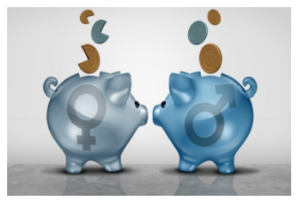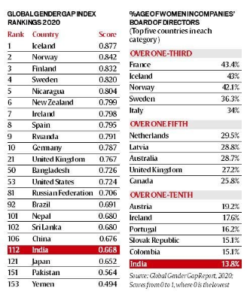UPSC Articles
SOCIETY
TOPIC: General Studies 1:
- Role of women and women’s organization, population and associated issues, poverty and developmental issues, urbanization, their problems and their remedies
Global Gender Gap Index, 2020(India has ranked 112th among 153)

Daily Current Affairs IAS | UPSC Prelims and Mains Exam – 18th December 2019
Context:
- India has ranked 112th among 153 countries in the annual Global Gender Gap Index for 2020,
- The Report was published by the World Economic Forum (WEF) recently.
- Iceland, Norway, and Finland occupy the top three spots in the Report.
The Global Gender Gap Index
- The Report benchmarks countries on their progress towards gender parity in four dimensions.
- The dimensions are: Economic Participation and Opportunity, Educational Attainment, Health and Survival and Political Empowerment.
- The Report aims to serve as a compass to track progress on relative gaps between women and men on health, education, economy and politics.
- It measures women’s disadvantage compared to men, and is not a measure of equality of the gender gap.
- Through this annual yardstick, stakeholders within each country are able to set priorities relevant in each specific economic, political and cultural context.

Daily Current Affairs IAS | UPSC Prelims and Mains Exam – 18th December 2019
Global Gender Gap Index for 2020: Key findings
- Globally, the average (population-weighted) distance completed to gender parity is at 68.6%, which is an improvement since last edition.
- The largest gender disparity is in political empowerment.
- Projecting current trends into the future, the overall global gender gap will close in 99.5 years, on average.
- There is a sharp deterioration in the economic opportunity gap, especially in women’s under-representation in emerging roles, such as cloud computing, engineering and data and artificial intelligence.
India’s Status
- India has slipped four places in the report to 112, behind neighbours China, Sri Lanka, Nepal and Bangladesh,
- It is due to due to rising disparity in terms of women’s health and participation in the economy.
- The country ranked 98th in WEF’s first report in 2006. Since then, it has fallen due to poor performance in three out of four indicators.
- India is also ranked in the bottom-five in terms of women’s health and survival and economic participation.
- The report showed that economic opportunities for women are extremely limited in India (35.4 per cent).
- India also ranked among countries with very low women representation on company boards.
- The report highlighted abnormally low sex ratios at birth in India (91 girls for every 100 boys).
- On health and survival, four large countries — Pakistan, India, Vietnam and China — fare badly with millions of women not getting the same access to health as men.
- India is the only country among the 153 countries studied where the economic gender gap is larger than the political one.
- On a positive note, India has closed two-thirds of its overall gender gap.
Way forward
- The Indian government needs to make sure that maternal and women’s healthcare is a top priority.
- It needs to increase efforts to skill more women in technology-based fields.
- Else, the potential of a large chunk of the population will remain unrealised.
Conclusion:
- Supporting gender parity is critical to ensuring strong, cohesive and resilient societies around the world.
- Diversity forms an essential element in the global economy too.
Connecting the dots:
- Do you agree that India badly needs to focus on improving women’s access to healthcare?
- What ways would you suggest to improve gender parity?













